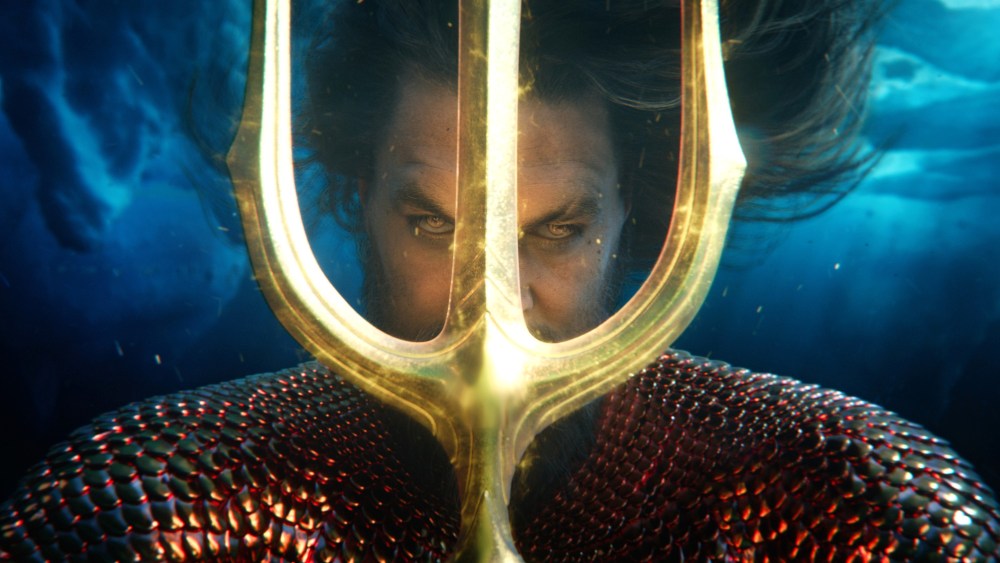Jason Momoa Sequel Is 3D but Flat
Starting in the 2000s, for a little over a decade, 3D was sold as a value-added feature of moviegoing, even though, with rare exceptions (e.g., the “Avatar” films), it never worked too well or added very much. (I would argue that it subtracted.) In most cases, 3D was a rip-off — a carny-barker way for studios to jack up ticket prices. That’s why the fad mostly faded away. It’s been a while since I was handed 3D glasses before walking into a movie screening, so when that happened before the media showing of “Aquaman and the Lost Kingdom,” it was hard not to wonder: Why are they gilding this sea lily?
As it turns out, “Aquaman and the Lost Kingdom” benefits from 3D significantly less than the first “Aquaman” (2018) would have. That movie was mostly a boilerplate DC origin story, but it wasn’t badly told, and the underwater sequences — the heart of the film — had a luminescent screensaver eye-candy-ness. It was fun to hang out in the ocean world of Atlantis, with its glowing creatures and ships shaped like manta rays, and to see Arthur Curry, a.k.a. Aquaman (Jason Momoa), claim his royal destiny as its supreme leader, even as he had to face off against his treacherous half-brother, King Orm, played by Patrick Wilson in slick blond hair that gave him the androgynous look and aura of an angry Katy Perry.
In “Aquaman and the Lost Kingdom,” Arthur, in his gleaming copper fish-scale muscle armor, is now the king of Atlantis, with the golden Lost Trident in his hand. Yet he seems to spend most of his time avoiding the place. He and the flaming-haired Mera — played, once again, by Amber Heard, who after her run in the tabloid spotlight is still very much in the franchise — are married now, with an infant son (who is already making the goldfish in their aquarium swim in circles), but they’re all living at Arthur’s father’s lighthouse. Arthur, by his own admission, finds leading the Atlantis high council to be a bureaucratic snooze.
Maybe that’s why “Aquaman and the Lost Kingdom” is less lyrical and wonderstruck, more battle-ready than “Aquaman” was. To defeat his nemesis, David Kane, a.k.a. Black Manta (Yahya Abdul-Mateen II), the glowering pirate whose face was scarred at the climax of “Aquaman” (he wears a red-eyed helmet that makes him resemble a digital-age version of The Fly), Arthur and his comrades must journey to corrupt kingdoms and dingy mines that look like discarded James Bond sets from the ’70s. They spend most of their time fighting: face to face, spear to spindly CGI monster, trident to trident. Does the 3D heighten the action? Not especially, but the real answer is: Nothing could heighten it. The movie, with all that combat, is staged on an impressively grand scale by the returning director, James Wan, but at the same time there’s something glumly standard about it.
Early on, there is one of those scenes that demonstrates the ever-shifting and arbitrary nature of power within the comic-book cosmos. Kane cruises into Atlantis with his team, who are piloting a submarine shaped like a hammerhead shark. Kane, who holds Aquaman responsible for the death of his father, is on a mad quest of vengeance. But what makes him think he can take on the entire Atlantan army? As it turns out, he now has a weapon even more forbidding than the Black Trident. He has tapped an ancient storage vault of Orichalcum, a fabled mineral of awesome power. (It also emits greenhouse gasses like nobody’s business.) The Kane forces are mining this toxic fluorescent-green secret weapon from a place so hidden that even Arthur, the overlord of Atlantis, has never heard of it. (For some reason they store the Orichalcum in containers that look like highway road-work barriers.) And the film’s secret weapon? Why, it’s that the whole thing is an allegory of fossil fuels and climate change! Are you excited yet?
Aquaman, introduced as a character in 1941, isn’t the first superhero of the comic-book-movie era to be a long-haired counterculture demigod, but Jason Momoa made him the first to be a bro — a hard-drinking, awesome-talking dude of the sea. Momoa played him like the world’s most valiant roadie for the Allman Brothers. If anything, that side of him now shows all the more, as Arthur’s main task is to form a bond with Orm, the Loki-like half-brother who despises him out of jealousy. They’re now united by having the same enemy, and spend the core of the film bantering on dry land, with Arthur trying to get a rise out of the uptight Orm. Wilson, though, seems a fishman out of water, less willowy and mysterious than he did in the first film. The chiding between the two plays like a half-hearted version of Taika Waititi snark. So does the casting of Martin Short as Kingfish, a corpulent gill-man who lays around like Jabba the Hutt. One misses the beatific sincerity of Willem Dafoe’s Vulko, who has gone the way of the sea.
This has already registered as the year when the MCU stumbled and maybe began its slow fall from cultural dominance. But, of course, it’s not just Marvel that people are weary of. It’s the numbing repetition of comic-book movies in general. It’s not as if DC is exempt. In “Aquaman and the Lost Kingdom,” all the talk about the alliance of the seven kingdoms, and the ominous figure of Kordax (Pilou Asbaek), and the malignant lost kingdom of Necrus wears you down. The monsters on display are meant to perk us up, but they, too, are unleashed in an onslaught that feels more random than not. It’s Kane’s plan to ignite an apocalyptic war with the land-dwellers. Can Aquaman, the half-breed superhero who lives in both worlds, unite them? The stakes are high, yet somehow not worth holding your breath over.

